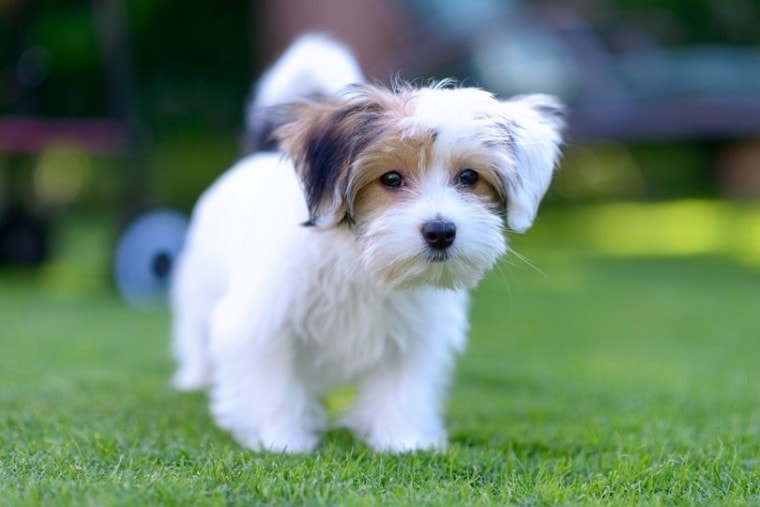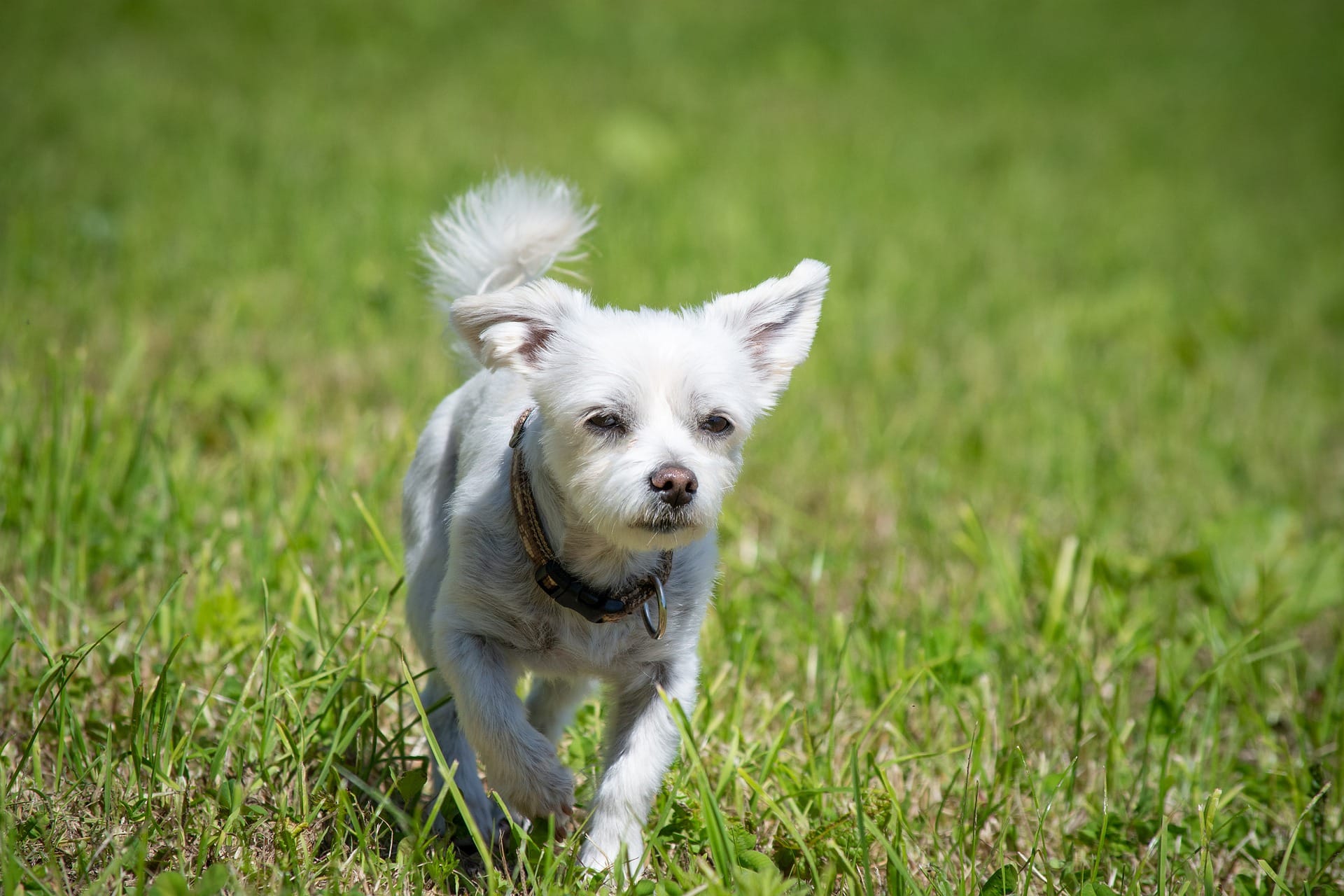
Click Below to Skip Ahead
The Havamalt is a designer dog created by breeding the Havanese and the Maltese. This hybrid originates in the United States and makes for a wonderful companion that is affectionate, intelligent, and loyal. Both Havanese and Maltese share similar ancestry and the Havamalt can take on traits from either parent.
Havamalts are small dogs, weighing anywhere between 5 to 15 pounds and only reaching 8 to 12 inches in height. They can resemble the look of either parent breed and come in a variety of coat colors including white, black, cream, silver, brown, and red. The Havamalt has a full double coat. The topcoat is usually a silky texture, while the undercoat will likely be more coarse.
Breed Overview
Height:
8 – 12 inches
Weight:
5 – 15 pounds
Lifespan:
12 – 15 years
Colors:
White, black, cream, silver, brown, red
Suitable for:
Those looking for a companion dog, elderly, families, first-time dog owners, allergy sufferers
Temperament:
Loving, smart, easy to train, cheerful, gets along with other pets
Havamalts have an average life expectancy of 12 to 15 years of age. Because they are not purebred dogs, they are not recognized by the American Kennel Club and have no breed standard.
The Havamalt is a playful, people-loving dog that will be well-suited for your lap. They tend to be easy-going and get along great with children and other pets. This hybrid would fit into just about any home, even if you’re a first-time dog owner.
Havamalt Characteristics
 Havamalt Puppies
Havamalt Puppies
The Havamalt is a result of two breeds that thrive on being with their family. They are fiercely devoted, people-loving dogs. This intense devotion can have a downside and can result in separation anxiety when left alone. They do best in homes where someone is home during the day to keep them company.
With separation anxiety, they may exhibit anxious behaviors such as pacing, whining, or trembling while you’re gone or as you leave. Some dogs can become destructive by chewing, digging, or using the bathroom on the floor.
Separation anxiety can pose a problem for some owners and if you do not have the lifestyle where someone is home all day, it’s best to begin training at an early age to try to prevent separation anxiety.
Another potential downside to the Havamalt is that they may not be the easiest to potty train. This isn’t uncommon in smaller breeds and both the Maltese and Havanese are known for their difficulty in potty training. They are intelligent dogs and do train easily in other aspects, but it is important to consider this before committing to a Havamalt.
You will want to begin consistent training at an early age and help your dog develop a routine to become a well-trained and well-mannered member of your household.

Temperament & Intelligence of the Havamalt
The Havamalt is very affectionate and intelligent. This sweet-natured dog will constantly crave human companionship and thrives on attention. They typically love everyone, including strangers, children, and other animals. They can be referred to as “velcro dogs” and will typically be stuck to their owner’s side whenever possible.
Their enthusiastic and playful personalities will make them quite fond of playtime. They are very smart and their people-pleasing tendencies leave them generally easy to train. They respond best to consistency and positive reinforcement during training.
Are These Dogs Good for Families? 👪
Havamalts make great family dogs. They thrive on human companionship and will be fiercely loyal to their owners. They generally do great adapting to their family’s lifestyle. Happiness for a Havamalt is nothing more than spending the day with you and snuggled up on your lap.
These dogs do great with children, though it is always best to supervise young children with any household pets. Havamalts are small and could easily be injured if a young child is playing too rough.
Does This Breed Get Along with Other Pets?
Not only are Havamalts great with families and children, but they are also great with other pets. Early socialization and slow introductions are always beneficial. Havamalts are very gentle and typically have no problem sharing their home with other animals once properly introduced.
 Things to Know When Owning a Havamalt:
Things to Know When Owning a Havamalt:
Food & Diet Requirements 🦴
The Havamalt should be fed high-quality dog food suited for their age and activity level. Their lineage from the Maltese can make them susceptible to hypoglycemia. Dogs with hypoglycemia will require a steady feeding schedule and should be discussed with a veterinarian.
Havamalts can also be prone to food allergies; this will be something the owner and veterinarian can be on the lookout for. Any concerns regarding the type of food, the quantity, or the frequency of feedings should be addressed directly with a veterinarian.
Exercise 🐕
Havamalts are playful and happy dogs and their exercise needs are moderate. They require daily exercise to keep them healthy and stimulated. Whether it be indoor or outdoor playtime or a daily walk, they will be happy spending quality time with their people.
Training 🎾
The clever Havamalt will quickly pick up on commands. They are fast learners and considered easy to train. Beginning training at an early age is important to ensure proper manners and basic obedience.
You’ll want to take a firm and consistent approach to obedience that includes lots of positive reinforcement through praise and rewards for a job well done.

Grooming ✂️
The Havamalt is hypoallergenic and not a heavy shedder. They do have a double coat and will require weekly grooming to maintain their long, silky hair and coarse undercoat. You may want to have a professional groomer on standby for haircuts.
The Maltese have trouble with tear staining, and lighter colored Havamalts may too. They will need their eyes wiped clean regularly to prevent staining as well, especially in white-colored individuals.
Their long hair on and around the ears may attract and trap dirt, debris, and moisture. You can avoid ear infections with regular cleansing. You will want to expose your Havamalt to nail trimming early, as it can be a frightful experience for a dog. They will need routine nail trimmings done either at home or at the groomer.
Health and Conditions 🏥
Most hybrid dogs fare well in terms of health. They will still be susceptible to some of the health conditions seen in their lineage. While typically very healthy, the Havamalt might be prone to a few health issues passed down from the Havanese and Maltese.
 Male vs Female
Male vs Female
Though male dogs are generally larger than females, this may not be the case for the Havamalt. Since they are a mixture of two different breeds, they can take on the traits of either parent causing their size to vary.
If they have not been spayed or neutered, male and female dogs will likely display different behaviors. Though Havamalts are very friendly in nature and love attention, the males tend to be the most laid back. They typically display a more docile demeanor and are more tolerant, playful, and affectionate.
That’s not to say that females lack a friendly, loving nature. They also have these qualities and bond very closely with their families. Females are just known to be a bit more moody and sensitive to their surroundings. Females display more of a need for dominance and tend to be more territorial. These are traits passed down from the Havanese.
3 Little-Known Facts About the Havamalt
1. The Havamalt Has Five Registrations as a Designer Dog
Since they are not purebreds, they are not eligible for AKC registration. However, the Havamalt is recognized by five different designer dog registries including, the American Canine Hybrid Club, the Designer Dogs Kennel Club, the Designer Breed Registry, the Dog Registry of America, and the International Designer Canine Registry.
2. The Havanese Is Part of the Bichon Family
The Havanese is the only breed native to Cuba and is part of the Bichon family. In the past, they have gone by the name of Havanese Cuban Bichon. The Havanese breed came close to extinction in the 1950s and 1960s. Thankfully, three families had left Cuba for the United States that were responsible for bringing their numbers back up. The Havanese was recognized by the American Kennel Club in 1999.
3. The Maltese Has Ancient Origins
The history of the Maltese likely dates back to the Phoenicians who brought the dog to Malta. The Greeks of the 4th and 5th century B.C. immortalized the breed in their art and Aristotle described the Maltese as “perfectly proportioned.”
Summary
The Havamalt is a friendly, affectionate, and sweet-natured designer dog that originated in the United States. As a hybrid of the Maltese and the Havanese, they can take on traits from either parent.
Havamalts are playful and loving. They make great dogs for families, first-time dog owners, and allergy sufferers. They can make excellent companions for the elderly since they enjoy having human company all day, every day. Unfortunately, they are prone to separation anxiety when away from their owners.
They are easy to train overall but can be difficult in terms of potty training. They stay small in size, are generally healthy, and typically live 12 to 15 years. You can expect to pay a hefty price tag for them, even though they don’t come with purebred status.
Overall, if you’re looking for a small, loyal, cheerful companion that can adapt to any living arrangement, the Havamalt may make a great choice for you!
Related reads:
- 150+ Havanese Names: The Best & Most Popular
- Havashire (Havanese & Yorkie Mix)
- Havaton (Havanese & Coton de Tulear Mix)
Featured Image Credit: Michaelheim, Shutterstock

 Havamalt Puppies
Havamalt Puppies Things to Know When Owning a Havamalt:
Things to Know When Owning a Havamalt:



